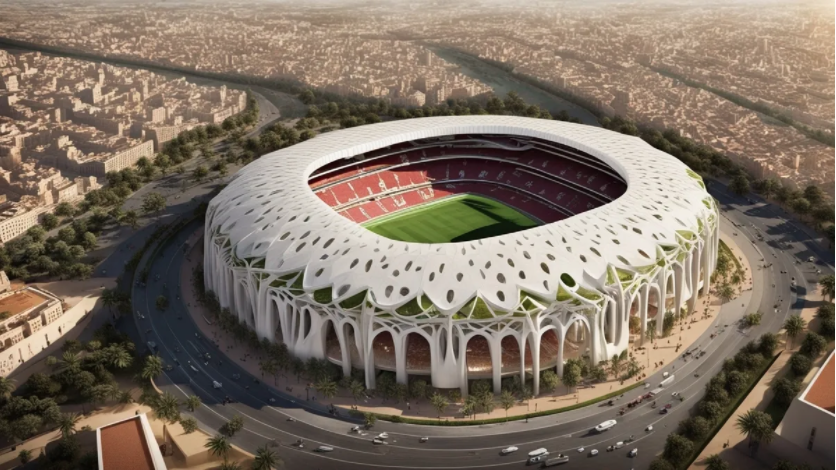- December 4, 2023
- Posted by: SportsV
- Categories: Design Competitions, Featured Articles, Features, Home News, Industry News, News, Press Releases

A total of seven groups have been shortlisted for the design of the Grand Stade de Casablanca, which will cost nearly five billion dirhams (c.€456m/$495m/£392m), as reported by the desk of dayFREURO.
The groups having been shortlisted to continue onto the next phase of the architectural competition for the Grand Stade de Casablanca, were all categorised as “eligible” without reservations.
The competition to find the future stadium design with a capacity of 115,000 seats and a construction budget estimated at 5 billion dirhams was launched on October 24.
Moving onto the second phase
Architect Abdou Lahlou, who has joined forces with the Swiss firm, Herzog & De Meuron, known for having created several museums and art spaces, but especially in the sports world, Munich’s iconic Allianz Arena.
Next, Fikri Benabdellah, who has formed an alliance with HPP Architekten, and partner Rachid El Andaloussi, along with Thornton Tomasetti and Henderson Engineers. HPP Architekten counts the Pudong Football Stadium in China as one of its signature projects.
The third group is led by the Moroccan architect Tarik Oualalou, with Populous, ME Engineers, Maffeis Engineering and Rider Levett Bucknall (RLB). Populous has delivered a plethora of projects in the sports and entertainment space, including the Tottenham Hotspur Stadium.
Moroccan firm Groupe 3 Architectes, has joined forces with Foster + Partners, Tecnica y Proyectos (Typsa) and the public design office Conseil Ingénierie et Développement (CID). Foster + Partners includes Wembley Stadium as a reference, and in Morocco, the firm has designed the Bab El Bahr real estate complex at the Salé Marina.
Designer of the Tangier-Tetouan-Al Hoceima University Hospital Center, the firm Atelier d’Architecture Hajji & El Ouali is also present, alongside the German firm GMP Architekten (known for projects including the Suzhou Olympic Sport Center and the Santiago Bernabeu), Schlaich Bergermann Partner (sbp), Hilson Moran and the engineering office subsidiary of CDG, Novec.
Author of the proposal for the Grand Stadium of Casablanca for the 2026 FIFA World Cup bid file, the Spaniard Cruz y Ortiz is also present. He is partnered with Charaf-Eddine Fqih Berrada, MJW Structures, Ing Majowjecki Massimo and JG Ingenieros SA.
Finally, the last group is that headed by the Moroccan architect Jaouad Khattabi, within his team is the international architectural firm Zaha Hadid Architects (ZHA), co-director of the Grand Théâtre de Rabat, along with Dar Al Handasah Consultants (Shair & Partners). ZHA has distinguished itself in terms of sport by building Al Janbou Stadium in Qatar, a 2022 FIFA World Cup venue.
A Vision of Grandeur
The project, spearheaded by the National Society for the Construction and Management of Sports Facilities (Sonarges) and the National Agency for Public Facilities (ANEP), envisions a state-of-the-art stadium with a seating capacity of 115,000. With a budget capped at 5 billion DH, this will be a venue unlike any other in North Africa, adhering to the latest international football standards.
The selected location for this colossal structure is in the province of Benslimane, a strategic midpoint between Casablanca and Mohammedia and in close proximity to the airport. The 100-hectare site offers enough room not just for the stadium but also for other associated facilities, potentially paving the way for a comprehensive sports complex.
The Grand Stade of Casablanca is not just about football, though; it is a symbol of Morocco’s ambitions on the global sports stage and a testament to the country’s commitment to enhancing its sports infrastructure. Beyond serving as a venue for football matches, the stadium is envisioned as a multifunctional hub capable of hosting a variety of sporting events and activities.
The benefits of the stadium extend beyond the confines of its walls. The project is expected to boost Morocco’s reputation as a sports destination, attract international events, stimulate the local economy, and create jobs. The arena’s capacity will also allow Morocco to host large-scale events, showcasing its capabilities as a host nation.
Sources: BNN.Network / dayFREURO
Image, courtesy: BNN.Network


